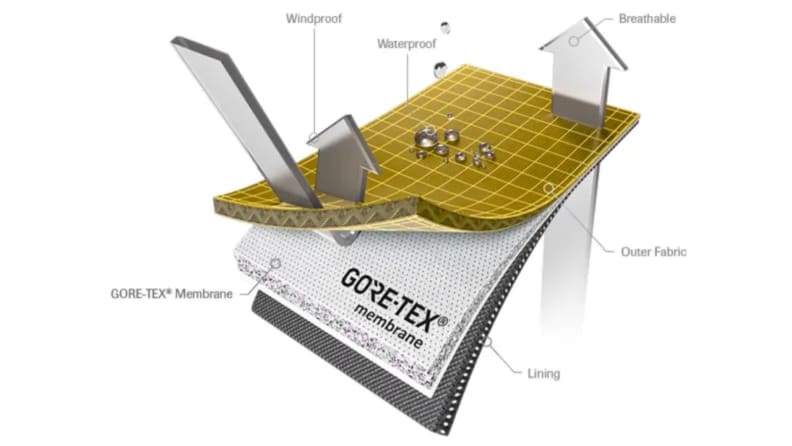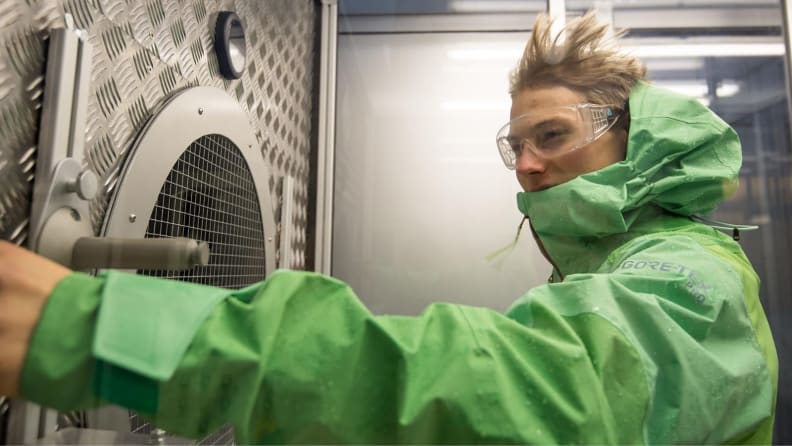What is Gore-Tex and what makes it an outdoor essential?
The science behind how this rugged material works
 Credit:
Gore-Tex
Credit:
Gore-Tex
Products are chosen independently by our editors. Purchases made through our links may earn us a commission.
When it comes to hardy, waterproofed outdoor clothing, no one technology stands out more than Gore-Tex. The branded tech is found in everything from ski jackets to windbreakers to hiking boots, and is sought after for its ability to repel water without leaving wearers feeling damp. After nearly five decades on the market, the technology is as popular as ever. But what exactly is Gore-Tex and how does it work? And is it worth the extra cost it adds to products made with it?
What is Gore-Tex?

This illustration shows how Gore-Tex's membrane works for water- and windproofing.
In simple terms, Gore-Tex is a breathable waterproof fabric membrane found in performance and technical clothing—items like ski jackets, raincoats, hiking boots, and work gloves.
Unpacking the science behind Gore-Tex is where it gets complicated. Gore-Tex is made of polytetrafluoroethylene (PTFE), which is a synthetic thermoplastic polymer. Polymers are a chain of molecules, sometimes seen as the backbone of chemicals, while "thermoplastic" refers to its ability to become pliable when undergoing temperature change.
The backbone of Gore-Tex was invented when Bob Gore in 1969, an engineer and chemist working for his father’s company, W. L. Gore & Associates, was experimenting with heated rods of polytetrafluoroethylene (PTFE) to create pipe thread. In a fit of frustration, he stretched the material out, thus creating expanded polytetrafluoroethylene, or ePTFE. The word “expanded” here is used in a literal sense—Gore discovered that by applying a sudden force to a heated rod of PTFE, he could stretch it by up to 800%. Initially, Gore slowly pulled the heated PTFE rods apart, attempting to stretch it by at least 10%, but soon discovered a sudden, forceful yank could provide the length he needed. When expanded, PTFE turns into a microporous substance made up of 70% air, making long, weavable filaments when stretched one-dimensionally, and sheets of a membrane when stretched two-dimensionally. When experimenting with laminates, or the process of manufacturing material with multiple layers, Gore combined these stretched membranes with the added support of fabrics such as nylon and polyester to create a waterproof laminate for fabrics.
Following his discovery, Gore filed a patent for the use of any “porous form of polytetrafluoroethylene with a microstructure characterized by nodes interconnected by fibrils” in 1976, and "waterproof laminate” in 1980. In other words, Bob Gore had patented the use of waterproofing fabric membranes. Gore’s signature polymer, ePTFE, was introduced to the public under the trademark of Gore-Tex.
Today, thermomechanically expanded PTFE is used as insulation for wires and cables, vents for protecting the audio quality of smartphones, textiles in space exploration, sealants, medical implants, and of course, high-performance fabrics.
How does Gore-Tex work?

Those who are in climates where harsh rain and snow can complicate an outdoor activity can benefit from Gore-Tex-branded jackets or shoes, where staying dry is important to health.
The Gore-Tex fabric membrane is tightly woven, with roughly 9 billion pores per square inch. Each pore is approximately 20,000 times smaller than a single droplet of water but 700 times larger than a water molecule. This makes the material “waterproof” while still allowing water vapor to pass through, making it “breathable.” This breathability is important in performance clothing, where insulation can cause wearers to overheat, and an abundance of trapped sweat and moisture can lead to bacteria growth and odor.
Raincoats and water-resistant jackets are usually made with two layers: a tough outer fabric shell made of nylon or polyester, and an inner lining of a polyurethane (PU) material, which provides water resistance. With Gore-Tex branded clothing, the fabric membrane is sandwiched in between the outer shell and liner. Additionally, the membrane is usually treated with a Durable Water Repellent (DWR). This helps water beads fall off of the fabric membrane before even having a chance to absorb in, allowing Gore-Tex to stay breathable during wet weather, as a build up of water on the outer material can prevent water vapor inside from evaporating out.
Although technically Gore-Tex lets air pass through, it can still feel hot to wear, similar to synthetics like polyester and nylon. Like those, ePTFE is made up of plastics and sometimes used as insulation in applications outside of clothing—it can trap in body heat as well as absorb some from the sun, meaning it’s best used for apparel to be worn in cooler climates. For Gore-Tex that’s weather-appropriate in warmer weather or for sweat-inducing activities, look for Gore-Tex Pro, Gore-Tex Windstopper, and Gore-Tex Infinium. Pro is considered a lighter, more breathable version of Gore-Tex that is highly abrasion- and snag-resistant—preferred clothing traits for mountaineers. Gore-Tex Windstopper is guaranteed to block all wind for snowy trips and winter sports, while Gore-Tex Infinium is a lighter version of Gore-Tex that is less water-resistant.
How to wash Gore-Tex

Jackets with Gore-Tex Pro are great for windproofing during cold gales or icy storms.
One downside of Gore-Tex technology is that its waterproofing doesn’t last forever. Dirt and debris can cause the membrane to become less effective overtime. To ensure your Gore-Tex is working properly, you should wash it regularly, according to the brand.
For outerwear, like jackets and vests, the company recommends washing pieces in warm water on a permanent-press cycle with a small amount of liquid detergent. The garment must be rinsed twice and spun on a very low setting to prevent wrinkles. The company doesn't recommend the use of powder detergents, fabric softener, stain removers, or bleach. Dry cleaning is also not recommended for any Gore-Tex product.
After washing, you can either line-dry your garment or machine-tumble it on a warm, gentle cycle. After it’s completely dry, the brand says to tumble-dry the Gore-Tex garment on low for an additional 20 minutes to “reactivate” its water-repellent treatment. Anytime you feel the fabric needs a water-repellency boost, washing your clothing and tumble-drying on low can help. You can also re-apply the DWR solution to your clothing yourself.
Is Gore-Tex worth it?

All Gore-Tex is waterproofed, making it functional performance gear.
All of that impressive technology comes at a price: Typically, outerwear made with Gore-Tex can run between $100 to $600 higher than non-Gore-Tex-infused gear, depending on the type of technology it uses. But if you’re someone who needs performance apparel and takes to the outdoors a lot, clothing made with Gore-Tex can certainly be worth the investment. All Gore-Tex is marketed as waterproof—with Gore-Tex Infinium being the exception—and breathable, to help ward off the elements and keep you comfortable. Those who are in climates where harsh rain and snow can complicate an outdoor activity can benefit from Gore-Tex-branded jackets or shoes, where staying dry is important to health.
However, if you’re just looking to buy simple pieces for warming up on a snowy day or something to toss on for a few minutes of light rain, the technology might be overkill. In those cases, a simple puffer jacket or nylon windbreaker should do the trick.
Additionally, because Gore-Tex’s patents around fabric membranes expired in 1997, many companies have presented their own ePTFE textile alternatives—namely, eVent, Polartec, and Pertex, to name a few. These brands carry similar membranes without the decades-old reputation—and in some cases, the price—of Gore-Tex.
